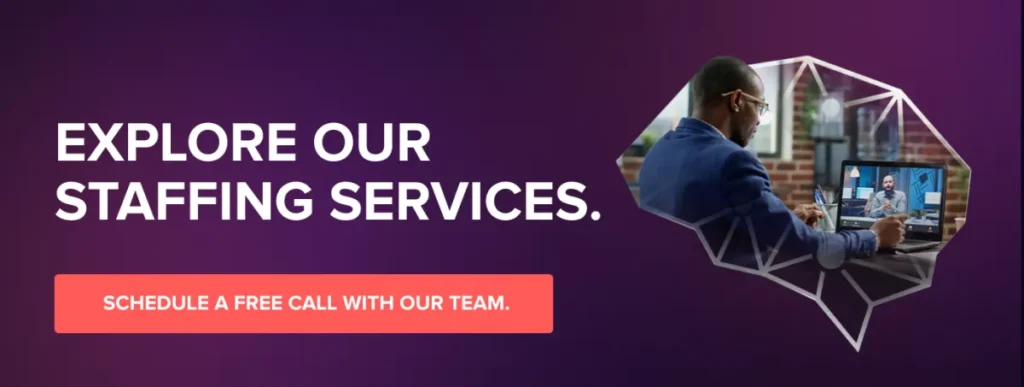Introduction

Welcome to the heart of customer interaction—the world where every exchange holds the potential to turn a routine encounter into a loyal customer relationship. Picture this: A young family enters a store, overwhelmed by the options available. They’re met not with indifference, but with the proactive, empathetic guidance of a Customer Experience Manager who not only assists them in making the perfect choice but ensures their experience is so delightful that they leave with plans to return. This isn’t just good service; it’s a strategic masterpiece crafted by a professional who transforms everyday interactions into lasting bonds.
For employers focused on drafting a stellar Customer Experience Manager job description, we have precisely what you need. Click the link below for a complimentary download of our top-tier job description template. This document encapsulates the fundamental principles and best practices of C9Staff’s renowned hiring methodology, providing you with a robust foundation to attract and hire the best talent.
Customer Experience Manager Job Description Template

Unfold the layers behind crafting and interpreting job descriptions for the architects of such memorable customer experiences—Customer Experience Managers. Whether you’re an employer looking to hire a champion of customer engagement, or a hopeful candidate aiming to step into these influential shoes, this guide is crafted for you. We’ll dive into both perspectives, ensuring that no stone is left unturned in understanding the full scope of this pivotal role.
But why emphasize a job description to such an extent? Because it’s far more than a list of qualifications and responsibilities. A well-crafted job description is your first interaction with potential talent—it sets the tone, communicates your values, and outlines the expectations that will drive your company’s success. It’s not just a document; it’s a foundational tool that attracts the right people who will carry forward your mission and enhance your organizational culture.
As we navigate through this session, remember, you are not just filling a position or seeking a job; you are setting the stage for operational excellence and transformative customer relationships. Stay engaged as we explore how to master this art, ensuring that your role as an employer or candidate aligns seamlessly with the strategic goals of customer experience management.
Understanding the Role of a Customer Experience Manager

As a seasoned Customer Experience Manager, I’m here to walk you through the essence of our role, its profound impact on the organization, and the blend of skills that make us effective leaders and strategists.
Defining the Role and Responsibilities
A Customer Experience Manager acts as the critical bridge between a company and its customers. Our primary responsibility is to ensure that every customer interaction is not merely a transaction but a step towards building a lasting and meaningful relationship. This means overseeing and enhancing all aspects of the customer’s journey—from initial contact through post-service follow-up—to ensure a seamless, positive experience that aligns with the company’s values and expectations.
The Impact on Business Success
The influence of effective customer experience management on a company’s success is undeniable. Consider a recent initiative by a leading tech company that revamped its customer service process. By implementing a new feedback system that directly channeled customer opinions to relevant departments, the company saw a 30% increase in customer satisfaction and a 25% rise in repeat business within just six months. These tangible improvements are a testament to how actively listening and responding to customer feedback can transform business performance and drive substantial growth.
Essential Skills and Qualifications
To thrive as a Customer Experience Manager, one must master a unique set of skills:
Soft Skills: Empathy, leadership, and excellent communication skills are paramount. These abilities allow us to understand customer emotions, lead diverse teams, and articulate customer needs to higher management effectively.
Hard Skills: Proficiency in data analysis and CRM software is essential. These technical skills help us to extract meaningful patterns from customer interactions, anticipate customer needs, and deliver personalized experiences.
Applying these skills in real-world settings often involves analyzing customer behavior trends, designing targeted customer satisfaction surveys, and coaching team members to deliver exceptional service.
For Employers: Crafting a Comprehensive Job Description

As HR professionals and business leaders, your role in creating a job description is pivotal in capturing the essence of what makes this position critical to your organization and in attracting the top talent it deserves.
Key Elements of an Effective Job Description
Let’s start by examining the core components of an effective job description:
Job Title: Ensure the job title clearly reflects the level of responsibility and the role within the organization. For example, “Senior Customer Experience Manager” implies a role with substantial experience and leadership responsibilities compared to “Associate Customer Experience Manager.”
Job Summary: This should be a compelling paragraph that captures the essence of the job and the company culture. For instance, “As a Customer Experience Manager at [Company], you will spearhead our mission to transform customer interactions into lifelong relationships by leading our front-line customer service team.”
Responsibilities: List specific tasks and long-term objectives. For a Customer Experience Manager, daily responsibilities might include monitoring customer service interactions and strategizing on service improvement. Long-term objectives could involve setting customer satisfaction goals and spearheading projects to achieve these targets.
Qualifications: Highlight necessary educational backgrounds, such as a bachelor’s degree in Business Administration, relevant experience—preferably in a customer-facing role—and technical skills like proficiency in CRM software. Also, include soft skills such as empathy, leadership, and communication.
Benefits: Clearly articulate the benefits offered, like health insurance, retirement plans, professional development opportunities, and perhaps flexible working conditions to attract the best candidates who are looking not just for a job, but for a place where they can grow and balance their personal and professional lives.
Tailoring the Description to Your Industry
Each industry has unique challenges and customer interaction models. For example:
In retail, a Customer Experience Manager might focus on in-store customer interactions and the seamless integration of online and offline experiences.
In technology, the emphasis might be on managing customer feedback loops to improve software or hardware offerings.
In hospitality, the focus could be on guest satisfaction and managing online reviews to enhance reputation.
Customize your job description to reflect these nuances, ensuring that the skills and experiences you list align with your specific industry’s needs.
Attracting the Right Candidates
To attract a diverse and qualified candidate pool, use inclusive language and clear expectations. For instance, avoid jargon that might dissuade qualified candidates who might not yet be familiar with industry-specific terms. Be transparent about job responsibilities and progression opportunities, which will help align your offer with the career aspirations of potential candidates.
Encourage crafting job descriptions that speak directly to candidates’ ambitions and potential contributions. For example, state that you value innovative solutions to customer experience challenges and are looking for a leader who can bring fresh perspectives to the team.
For employers focused on drafting a stellar Customer Experience Manager job description, we have precisely what you need. Click the link below for a complimentary download of our top-tier job description template. This document encapsulates the fundamental principles and best practices of C9Staff’s renowned hiring methodology, providing you with a robust foundation to attract and hire the best talent.
Customer Experience Manager Job Description Template

For Job Seekers: Interpreting Job Descriptions Accurately

Let’s break down the job descriptions you’ll encounter so you can apply with precision and confidence.
Decoding the Job Requirements
When you’re looking at a job description, it’s essential to read beyond the basic requirements. Focus on the skills and experiences that are repeatedly emphasized. For instance, if you notice frequent mentions of “conflict resolution” or “team leadership,” these aren’t just casual mentions; they are core competencies you must have. Your task is to reflect on your past roles where you’ve honed these skills and be ready to discuss these experiences in your applications and interviews.
Assessing Company Culture Through Job Descriptions
Job descriptions often give away subtle hints about a company’s culture. Words like “innovation-driven” suggest a forward-thinking approach, possibly a startup vibe, where agility and ideation are prized. On the other hand, a phrase like “team-oriented” might indicate a collaborative environment, where success is not just about individual contribution but how well you work with others. By picking up on these nuances, you can gauge whether your personal values align with those of the company, which is crucial for long-term job satisfaction.
Preparing Your Application
Now, let’s talk about tailoring your application. It’s not just about tweaking your resume but aligning it with the job description. Use similar language and address the qualifications and responsibilities listed. For example, if the job description highlights the importance of “enhancing customer loyalty,” include a bullet point in your resume that shows how you implemented a strategy that significantly improved customer retention rates in your previous role.
Remember, your resume and cover letter are your first opportunities to show that you speak their language and that you understand what they care about. Make it clear why you are not just a suitable candidate but the ideal candidate for the position.
As you navigate your job search, keep these strategies in mind. They are not just tips but essential tools that empower you to apply strategically and stand out in a sea of applicants. You’re not just searching for any job—you’re building a path to a career that matches your skills and passions. Good luck, and let’s make your job application as impactful as possible!
Are you ready to supercharge your career and land your dream job? Submit your resume to C9Staff’s talent acquisition department today. If your qualifications align with our client requirements, we’ll be in touch to explore potential opportunities that match your profile. Don’t miss the chance to connect with leading employers and take your career to new heights. Click below to get started!

Mastering CXM: The Definitive Guide for Businesses to Elevate Customer Experience
Trends in Customer Experience Management

The era of digital transformation has fundamentally changed how we interact with customers. Today’s Customer Experience Managers must harness the power of omnichannel communication platforms to deliver a seamless and personalized service across various touchpoints—be it social media, live chat, email, or in-person interactions. These technologies enable managers to maintain a consistent brand voice and ensure customer satisfaction at every stage of the customer journey.
Artificial Intelligence in Customer Service
Artificial intelligence is revolutionizing customer service by introducing efficiencies that were previously unattainable. Chatbots, AI-driven analytics, and automated response systems are now at the forefront of customer interaction. These tools provide Customer Experience Managers with deep insights into customer behaviors and preferences, allowing for predictive analytics that can anticipate customer needs before they even articulate them. The result? More effective decision-making and a proactive approach to customer service that keeps your brand a step ahead.
Sustainability in Customer Experience
Sustainability is no longer just a buzzword but a business imperative. Consumers are increasingly drawn to brands that demonstrate a commitment to environmental and social responsibility. As a Customer Experience Manager, integrating sustainability into your customer interaction strategy is crucial. This means ensuring that your operations minimize environmental impact and that your customer service practices reflect the ethical standards expected by today’s consumers. It’s about building a brand that customers trust and are loyal to because they see their values reflected in your actions.
Expanding Roles and Responsibilities
These trends necessitate a significant expansion in the role of the Customer Experience Manager. With digital transformation, you are expected to be adept at both technology and human resource management—creating cohesive customer experiences that integrate digital and human elements flawlessly. With AI, you need to oversee the integration of technology solutions that not only support but enhance customer interactions. And with the rise of sustainability, you are tasked with ensuring that every customer interaction not only meets efficiency standards but also aligns with broader ethical and environmental goals.
As you navigate these changes, remember that your role is crucial in shaping the future of customer experience. Embrace these trends, understand their implications, and use this knowledge to position yourself at the forefront of your profession. Let’s continue to adapt, innovate, and lead in creating exceptional customer experiences that are not only effective but also responsible and forward-thinking. Thank you for joining me today, and let’s pave the way for a new era of customer experience management together.
Employers seeking to optimize their recruitment for Customer Experience Manager roles are invited to discover how C9Staff can elevate your hiring process. Schedule a free exploratory call with one of our account managers today. During this call, we’ll attentively listen to your needs and recommend potential candidates at no cost, helping you assess the best talent available at competitive prices. Take the first step towards securing top-tier professionals tailored to your organizational needs.

Conclusion

As we conclude this comprehensive workshop on the pivotal role of Customer Experience Managers, let’s consolidate the essential insights we’ve explored today, tailored for both employers and job seekers.
Customer Experience Managers are at the heart of transforming customer interactions into long-lasting relationships. Their strategic role significantly impacts a company’s success, making every customer touchpoint an opportunity for enhancement and loyalty building. For businesses, the creation of a meticulous job description is not just a procedural task—it’s a critical strategy to attract the right talent. These descriptions should reflect the actual responsibilities and align with the company’s broader goals and culture, ensuring that expectations are clear and mutual from the start.
For Employers: Take these insights and reflect them in your job descriptions. Craft each description to be detailed, clear, and inclusive, transcending beyond mere listings of requirements. View these descriptions as strategic tools essential for attracting professionals who will not only fill a role but will drive customer satisfaction and loyalty to new heights.
For Job Seekers: Approach your job applications with a strategic mindset. Utilize the insights from this workshop to accurately decode job descriptions, assess the underlying company culture, and tailor your applications. Show how your specific skills and experiences make you the ideal candidate, aligning precisely with the job’s demands and the company’s ethos.
This workshop is not just a lesson, but a call to action for both employers and job seekers. Employers, by refining how you communicate your needs, you attract better-suited candidates. Job seekers, by understanding and responding to these refined messages, you position yourselves as the ideal candidates who are fully aware of what the role entails and are ready to contribute effectively.
Let this be a stepping stone towards enhancing your recruitment strategies or job search techniques, ensuring that each party’s needs and expectations are not just met, but exceeded.




